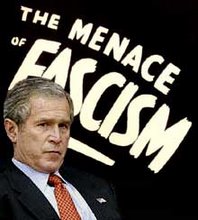In the 1980s, a secret group of planners inside and outside the government were assigned, by an Executive Order, to develop a response to a nuclear attack in which the U.S. government had been decapitated, forcing an alternative to the constitutional rules of succession. Two of these planners were Dick Cheney, then a Congressman, and Donald Rumsfeld, then a private citizen and CEO of the G.D. Searle drug company.
"One of the awkward questions we faced was whether to reconstitute Congress after a nuclear attack.It was decided that no, it would be easier to operate without them," said one of the COG planners in the 1980s, who spoke to James Mann (The Rise of the Vulcans, 141-42). James Bamford reported the same remark in his book Pretext for War (p. 74).
After the end of the Cold War, the urgency of coming up with plans faded. The COG nuclear planning project "has less than six months to live," reported Tim Weiner of the New York Times. (April 17, 1994). Mann and Bamford concluded, wrongly, that all the COG planning of the Reagan era had been abandoned.
In fact, Reagan's Executive Order 12656, issued in 1988, remained in effect. The order states that Continuity of Government procedures are called for in the event of "any occurrence, including natural disaster, military attack, technological emergency, or other emergency, that seriously degrades or seriously threatens the national security of the United States." (4)
Under Clinton, some parts of the planning, presumably military, were continued by a group including Rumsfeld and others whose roster (according to Andrew Cockburn) was "filled almost exclusively with Republican hawks." Cockburn quotes one participant, a former Pentagon official, who said "They'd meet, do the exercise, but also sit around and castigate the Clinton administration in the most extreme way." (5)
According to the 9/11 Commission Report (p. 326; cf. p. 38), "Contingency plans for the continuity of government" were implemented on September 11, 2001. (6) But what measures were invoked remains unclear.
Some clues may be supplied by COG's past history. COG planning in the 1980s was handled by the Federal Emergency Management Agency and its controversial director, Louis Giuffrida. According to a Miami Herald article by Alfonso Chardy on July 5, 1987, Giuffrida's plans included "suspension of the Constitution," along with detailed arrangements for the declaration of martial law. (7)
Those suspicious of what COG means today have pointed to a number of post 9/11 steps to facilitate the implementation of martial law, including the creation of a new military command (NORTHCOM ) for the continental United States. They note also Homeland Security's strategic plan Endgame, whose stated goal is the creation of detention camps designed to "remove all removable aliens," including "potential terrorists."
Then in 2007 National Security Presidential Directive 51 (NSPD 51 ), issued by the White House, empowered the President to personally ensure "continuity of government" in the event of any "catastrophic emergency." (8) According to the Washington Post (May 10, 2007), this directive "formalizes a shift of authority," from the Department of Homeland Security to the White House, in establishing " a shadow government " after an emergency. (9) Congress has yet to hold a single hearing on NSPD 51. (10)
NSPD 51 contains "classified Continuity Annexes" which shall "be protected from unauthorized disclosure." Congressman DeFazio twice requested to see these Annexes, the second time in a letter cosigned by House Homeland Security Committee Chairman Bennie Thompson and Oversight Subcommittee Chairman Christopher Carney. It was these requests that the White House denied.
Without full disclosure, such suspicions will only fester and distract from the real issue: the role of Congress in constitutional government. In the event of national emergency, Congress must be at the heart of the defense of democratic government and American territory. It is reasonable for the citizenry to ask, "How do Continuity of Government plans preserve and protect the role of the popularly chosen branch of government?" The answer is, we simply don't know.
DeFazio's inability to get access to the NSPD Annexes is less than reassuring. If members of the Homeland Security Committee cannot enforce their right to read secret plans of the Executive Branch, then the systems of checks and balances established by the U.S. Constitution would seem to be failing.
To put it another way, if the White House is successful in frustrating DeFazio, then Continuity of Government planning has arguably already superseded the Constitution as a higher authority.
Will Congress insist on its right of review COG planning? The answer to this question will depend on discussion in the blogosphere, the degree of pressure exerted by the electorate on their representatives, and the questions asked the men and women who would be president.
Peter Dale Scott is the author of The Road to 9/11.
Notes.
1. Congressional Record, August 2, 2007. The text of National Security Presidential Directive 51 can be seen here.
2. Jeff Kosseff, The Oregonian, July 20, 2007.
3. Scott, The Road to 9/11, 183-87; citing Ross Gelbspan, Break-ins, Death Threats, and the FBI: The Covert War against the Central America Movement (Boston: South End Press, 1991), 184; Alfonso Chardy, Miami Herald, July 5, 1987.
4. The provisions of Executive Order 12656 of November 18, 1988, appear at 53 FR 47491, 3 CFR, 1988 Comp., p. 585, "Executive Order 12656-Assignment of Emergency Preparedness Responsibilities,". The Washington Post (Gellman and Schmidt, "Shadow Government Is at Work in Secret," March 1, 2002) later claimed, incorrectly, that Executive Order 12656 dealt only with "a nuclear attack."
5. Andrew Cockburn, Rumsfeld: His Rise, Fall, and Catastrophic Legacy (New York: Scribner, 2007), 88)
6. 9/11 Commission Report, 326, cf. 38; Scott, Road to 9/11, 220-29.
7. Alfonso Chardy, "Reagan Aides and the `Secret' Government," Miami Herald, July 5, 1987.
8. National Security Presidential Directive 51.
9. Spencer S. Hsu, "Bush Changes Continuity Plan: Administration, Not DHS, Would Run Shadow Government," Washington Post, May 10, 2007,
10. Lewis Seiler and Dan Hamburg, San Francisco Chronicle (February 4, 2008).



